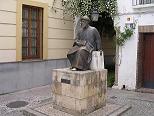Cordoba Info
Cordoba Hotels
Restaurants
Food
Photos
Map
History
Monuments
Museums
Festivals
Events
Weather
Practical Info
Tips for visitors
Spanish courses
Province
About us
Email
The Jewish Quarter is the best-known part of Cordoba's
historic centre, which was declared a World Heritage
Site by UNESCO in 1984 and is one of the largest in Europe. To
the northwest of the Mosque-Cathedral along the city wall, its medieval
streets have a distinctly Moorish flair to them, reminiscent of the Jews'
prosperity under the Caliphate of Cordoba. This neighborhood's history
is a history of the Caliphate and of the West. Of special interest are
the Synagogue and Souk.



Jews formed a part of Cordoba's cultural mix from as
early as the 2nd Century until their expulsion from Spain in 1492. Under
the Moslems, both Jews and Christians were given religious freedom and
self-governing communities. This arrangement was profitable to their rulers,
who improved their tax revenue with special household taxes for non-Moslems.
During the 11th and 12th centuries the Jewish population in Spain reached its point of greatest prosperity, intellectual energy and well-being, coinciding with Cordoba's greatest moment in history. Cordoba was the star of western Europe, seat of an independent Caliphate and a center for prosperity, commerce and learning in the midst of the so-called Dark Ages. Its mosque rivaled that of Damascus, its markets and palaces amazed travelers, and scholars came from afar to its prestigious university and library. When the very light of civilization flickered among poverty and ignorance to the north, Cordoba's paved streets were illuminated with street lighting.
The Jewish community thrived under the religious tolerance
of the Caliphate, and contributed actively to its prosperity and intellectual
energy. Hasday ben Shaprut, the governor
of the Jewish community, became an influential minister to the first Caliph,
Abd al-Rahman III, increasing his people's
well-being and turning Cordoba into the most significant center of Jewish
learning and culture in the world, taking the place of the Babylonian
School.
With the fall of the Caliphate in 1031, however, came
the decline of both Arab and Jewish vitality in Cordoba. Civil war and
the religious intolerance of the Almohad berbers from North Africa laid
waste to much of the city's prosperity. Gone were the outlying palaces,
large neighborhoods, wide avenues and orderly markets which extended beyond
the city walls. Many Jews fled to Christian territories in the north of
Spain or abroad. With the end of peace and religious tolerance in Cordoba,
the city's political, economic and cultural greatness evaporated, leaving
only traces of aristocratic superiority in the wounded consciousness of
its provincial inhabitants for the next 30 generations.

One of the brilliant minds to abandon the former capital
at this time was Maimonides (1135-1204),
who went into exile with his family to finally settle in Egypt. He became
one of the two most-studied Jewish philosophers of all time (also recognized
by Christians and Moslems as a revolutionary religious thinker), as well
as a physician. Among his works are the great Misneh Torah and the controversial
Guide to the Perplexed. Until recently, only a stone in the courtyard
of the synagogue commemorated him.
When Fernando III took Cordoba from the hands of the bickering Moorish Taifa Kingdoms, the Jewish community once again briefly prospered under Christian rule, maintaining their self-governing community, as in Moslem times. The last Jewish neighborhood we know of in Cordoba was separated and protected by walls on all sides, and lay approximately within the triangle formed by the city walls from Almodovar Gate to the Arab baths (once the northern, walled limit of the old Alcazar), Manríquez/Deanes streets and Almanzor street. Outside Almodovar gate there was once a Jewish cemetery.
In 1315 Simon Majeb built the Synagogue (*) which still stands today. It is one of the three significant synagogues remaining in Spain and is largely unaltered (its Mudejar reliefs were covered and it was used as a rabies hospital, seat of the shoe-makers' guild and finally a 19th-century primary school). The buildings around it were probably used as public baths and a Talmudic school.
The rest of the neighborhood has a distinctly Islamic air. Nearby is the Zoco (Souk), a medieval version of the famed Arabic souks which used to dot the urban landscape of the Caliphate. Below the oldest houses are Roman remains, and while some of the houses are higher and increasingly modern, they respect the ancient urban layout.
Anti-Semitic Papal bulls in the 1340s and local jealousy
of Jews' wealth and influence lead to their neighborhood being stormed
in 1391 and an end to their isolation. Perhaps at this time the eastern
and southern walls and their 2 gates were torn down, disappearing along
with the northern walls of the old alcazar, which used to enclose the
Arab baths, just outside the Jewish Quarter. In 1492, as a part of their
consolidation of power over a newly unified Spain, Ferdinand
and Isabel presented the Jews with the choice of forced conversion
or exile in 1492, causing the mass emigration of the Sephardic Jews from
all over Spain.
Many families fled from Spain taking the key to their
homes, which some still preserve down to this day, along with a medieval
Spanish dialect, called Ladino. Cordoba remembers their presence only
in its place names.
Support Infocordoba: reserve your Cordoba hotels through one of our reputable partners


